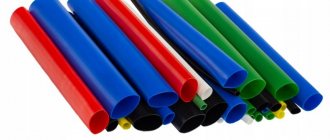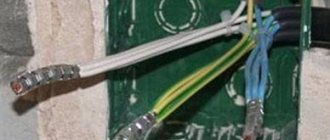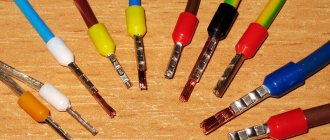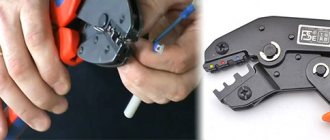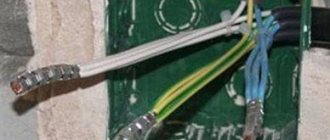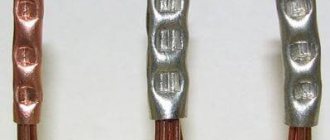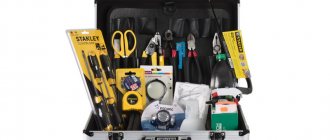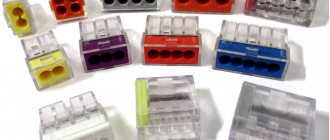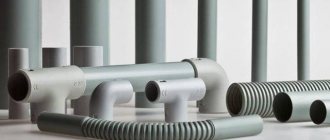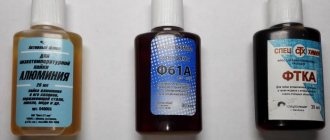For high-quality switching of electrical wiring and cable routes with input-distribution, grounding and other devices, it is important to use cable lugs. They crimp the ends of the wires. This is not done with bare hands, but with the help of a special tool.
Crimpers, or pliers for crimping wire lugs, guarantee high-quality contact and a reliable connection. They can be used for crimping various types of terminals - insulated and non-insulated, sleeve and sleeve. The device also allows you to crimp car terminals.
Historical perspective
Initially, as a tool, pliers were intended to remove hot metal blanks and crucibles of molten metal from forges.
They were also used by blacksmiths to hold various workpieces during forging. Archaeologists prove that the prototype of pliers - tongs, which had a rod-axis - was invented back in the Neolithic era. Back then this instrument was made from burnt wood. The first depiction of hand pliers tools dates back to the 6th-5th centuries BC. In the Bronze Age, blacksmiths used primitive pliers as clamps. They are currently found in the burials of blacksmiths as burial goods, indicating that the deceased had a special and fairly high social status.
Since ancient times, pliers have been two castor beans connected by a rivet that acts as an axis. This tool has been evidence of specialized blacksmithing skills since ancient times. Together with the anvil and hammer, pliers were an attribute of numerous ancient Greek and Roman blacksmith gods and lords of thunder (Thor, Vulcan, Hephaestus, etc.).
Much later, pliers began to be used in construction work, in plumbing activities, widely used in electrical work, etc. Depending on the specialization and principle of the device, various pliers are called side cutters, pliers, wire cutters, pliers, etc.
Why do you need crimping and crimping wires?
Is it even possible to do without sleeves and crimping? What's wrong with simply attaching wires to machines and other devices?
With a simple clamp, the bundle of wire fluffs up and is crushed to the sides. Some individual conductors may even be damaged. Such conductors, destroyed and separated from the main bundle, no longer take part in contact and the passage of current load through themselves.
All this leads to the fact that the remaining cores are not enough and the connection points heat up. In addition, the bare copper from which the wire strands are made remains accessible to moisture and oxygen. And this leads to its darkening and oxidation. By crimping the conductor once with a tip or sleeve, you will save yourself from all these problems in the future.
How to choose the right wire and tip
First, you need to find out what cross-section of wire you will be crimping. This can be done by following the inscriptions on the core insulation, or using a caliper. Further, when choosing certain sleeve tips, you can be guided by the color marking of their insulated skirt. Each color must correspond to a specific section and size of the tip sleeve.
True, there are also manufacturers who don’t bother with this and produce single-color products of different sections. After choosing, be sure to physically check how tightly the wire fits into the sleeve or tip. In this case, there is absolutely no need to twist the wires before inserting them into the tip.
The tip at the entrance has a special skirt that will help you put it on even a slightly fluffy wire. In addition, this skirt acts as an insulation retainer. You can compare how many kinks in different directions the wire will withstand and without a skirt. As you understand, the result will not be in favor of the latter option.
Another important point that needs to be remembered: many wires are manufactured not according to GOST, but according to their own technical conditions.
And therefore, their actual cross-section may be less than that stated in the nomenclature. Accordingly, because of this, a slack is formed in the pressed part of the tip, although as it seemed to you, you selected everything according to the tables and seemed to have made no mistakes anywhere.
It often happens that a 2.5mm2 wire easily fits into a tip with a cross-section of 1.5mm2. Therefore, choosing from tables is, of course, good, but you can’t do without practical fitting of the sleeved part and wire.
Methods for connecting plastic pipes
When installing a pipeline made of metal plastic (PEX-AL-PEX), the following methods are used to connect pipe sections to each other and connect technical fittings to fittings:
Crimping Crimping or compression fittings for metal-plastic pipes allow you to connect metal-plastic pipelines to the manifold distribution combs when laying heated floors without the use of special tools.
To do this, the end of the PEX pipe is put on the fitting, its inner shell is pressed against the outlet using an external union nut and a crimp ring with a slot (cracker). In a similar way, pipe sections are joined together by inserting compression fittings into them and squeezing them on top with a union nut.
It is worth noting that the crimp connection may weaken after a few years and will need to be tightened with a union nut, so this technology is used only for external laying of pipelines.
A significant advantage of the compression connection is the ability to disassemble it, which makes it easy to dismantle or repair operations with the replacement of pipeline sections.
Rice. 2 Compression and push fittings
Push fittings. A relatively new method of joining PEX pipes that does not require special tools and takes only a few seconds. The PEX pipe is simply inserted into the push fitting, where it snaps and securely locks in position, after which the connection can be disassembled or cannot be disassembled (depending on the brand of the manufacturer).
The advantages of push fittings include the fastest installation speed; the disadvantage is their high cost and the use of devices only for open installation.
Press fittings. Unlike previous options, a press connection requires a special tool - pliers. The pressing technology is as follows: a fitting with pointed outer ribs (herringbone) is inserted into the PEX pipe, a sleeve is simultaneously placed on top of the pipe casing, after which it is crimped with pliers. As a result, the compressed sleeve presses on the inner pipe walls, pressing them tightly and hermetically to the outer surface of the fitting.
The press connection is non-separable; due to its high reliability, the pipeline can be laid in a hidden way in wall grooves or under floor screed.
Rice. 3 Installation of connections with press fittings using press pliers for metal-plastic pipes
Article on the topic:
What are the types of fittings for metal-plastic pipes, installation features. The article describes options for connecting metal-plastic pipes, types of fittings, an overview of leading manufacturers and installation instructions.
Crimping solid wires
Many people often wonder whether it is possible to crimp solid wires? Yes, of course, it is not prohibited to do this, you just need to use the appropriate tool for this. Ordinary crimpers are no longer suitable here, since they are designed for less force required when compressing a monocore. You will have to purchase specially designed press pliers PK-16u or PK-35u for this.
This is a universal tool and can also be used for crimping stranded wires. In order for the compression on the monocore to be high-quality and there is no play inside the sleeve, the basic rule here is to choose a sleeve or tip one size smaller than the cross-section of the wire being pressed. These pliers are also convenient for pressing several conductors simultaneously in one sleeve. This is done, for example, when making connections in junction boxes.
Tip material
Another relevant point in choosing a tip is the material of manufacture. When purchasing, make sure that they are selling you copper or tinned tips. To do this, it is enough to first purchase one tip and file it with something foreign.
With copper material, especially if high-quality copper is used, the cut will be reddish in color. If ordinary copper alloys are used, which is most often the case, then the cut will be a pale yellowish color.
When exposed to air, copper may darken and lose contact quality. Copper tinning is a long-known method that makes the contact durable and reliable.
Advantages of crimping wires with lugs
- the crimped end of the wire is considered airtight
- the ferrule sleeve prevents individual wires from being damaged or excluded from contact
- tinned tip surface – reliable protection from environmental influences
GOST
GOST has not been developed for the crimpers themselves, but literally all types of tips with which this tool works are standardized.
This means that the crimper dies are also manufactured to the tip standards.
So the following GOSTs are considered the most popular:
- For cable lugs this is GOST 23981-80 and 9581-80;
- For cable sleeves these are GOST 23469.0-81, 23469.2-79 and 23469.3-79;
- For cable pin lugs these are GOST 23598-79 and 22002.5-76;
- GOST 9688-82 has been developed for cable ring lugs.
Pliers, pliers, round nose pliers, pliers and wire cutters
Main types of ticks
Crimping pliers are divided into two types. The most common type is a design that works like pliers. That is, the sleeve is compressed on both sides. Other pliers are diaphragm crimpers. Crimping pliers.
Pliers
The tip is crimped in the same way as pliers grip a part. The working surface of the dies has cutouts into which the tip shank is threaded. This design is suitable for those fastenings that do not require special reliability.
To increase crimping force, hydraulic ferrule crimping tools were invented. Thanks to this improvement, the pliers became more efficient. The design uses cylinders with pistons filled with oil, which creates a large pressure of the matrices on the tip sleeve.
Pliers with removable dies
Some crimpers are equipped with several types of removable matrices. The versatility of the tool eliminates the need for pliers for each conductor cross-sectional size.
Diaphragm pliers
The originality of the design of diaphragm crimpers lies in the comprehensive coverage of the tip shank. The principle of operation is similar to the movement of the aperture blades of photographic lenses. The only drawback of such devices is the impossibility of inserting pliers into the connection of the two ends of the wires.
The diaphragm tool is used as a press for pin or flat metal tips. The all-round clamp is much more effective than the plier type for covering the end switches of wire products.
Design features of adjustable pliers
Since adjustable pliers are the most versatile tool, it is worth getting to know their design features in more detail. Based on the type of mechanism used, adjustable pliers are divided into two categories of tools.
The adjustable mechanism can consist of an axis fixed to the movable jaw of the tool and a groove on a stationary clamping element, which is a series of aligned circles. On the axis, so that it can be moved along the groove and thereby adjust the degree of opening of the jaws, a sector is specially cut out. This adjustable mechanism works as follows: the axis for moving along the groove is rotated so that its bevel is parallel to the side of the cutout. Having positioned the axis in this way, the adjustable pliers are set to the required amount of jaw opening.
Pliers with grooves on the fixed part.
More common are adjustable pliers, the jaw opening mechanism of which is made according to the so-called American system. On the fixed jaw of such pliers there is a number of circular grooves along which the “tide”, made on the movable handle of the tool, moves.
Pliers with circular grooves.
To adjust the degree of opening of the pliers, you must perform the following steps:
- Remove the “tide” from its engagement with the side walls of the grooves.
- Place the mite lips as far apart as possible from each other.
- Place the tool handles in the required position and bring them together again.
Adjustable pliers equipped with a mechanism of the second type are considered more reliable and easier to use.
Many experts, when comparing adjustable plumbing pliers with conventional adjustable wrenches, emphasize that the former are easier to use and the required degree of opening of their working jaws is carried out more quickly. As a rule, adjustable pliers, equipped with adjustable mechanisms of both the first and second types, have about seven fixed positions of the clamping jaws.
Pliers
Pliers are a type of pliers that have a flat working surface. Often it is equipped with small notches. They are designed to grip and hold relatively small parts. For ease of working with parts, two such tools are sometimes used at once. They can have various shapes of working surfaces, which is why they got their name: long-nose pliers, duck-billed pliers, narrow-nose pliers. Often, pliers are equipped with cutting edges designed for cutting wire.
Combination pliers are also called pliers. Such tools include pliers equipped with a cutting edge for cutting nails and wire, and serrated grooves designed to hold tubes, nuts and other cylindrical parts.
Round nose pliers
The difference between round-nose pliers and pliers is the circular cross-section of the jaws, which taper towards the end (cone-shaped jaws). Round nose pliers are designed for curly bending of wire; the conical shape of the jaws makes it possible to make bends with different radii; they are an important tool for jewelers. Round nose pliers can have jaws of different sizes, both in length and thickness, and there are models that have jaws of different shapes in one tool, and there are round nose pliers with curved jaws.
Review of the best press pliers for crimping metal-plastic pipes
Valtec with nozzles 16-20-26-32
A high-quality model of the radial type, which is used for manual crimping and crimping of press fittings of various pipelines, the installation of which used pipes made of copper and polymers. This device can be used for processing thin-walled pipelines made of stainless steel.
The force for crimping pipes primarily depends on the length of the device handles and can be adjusted thanks to the press head mechanism. It is worth noting that the press head can rotate 360 degrees in relation to the handle of the device. The total weight of this press model (excluding the weight of the attachments used) is 3.1 kg. The profile of the nozzles that come with the device is TN. The device is made of tool steel. Country of origin: Italy.
Valtec with nozzles 16-20-26-32
Advantages:
- Versatility;
- Light weight;
- The press head rotates 360 degrees;
- Long handles;
- Convenient to use.
Flaws:
- Price (12212 rubles).
JT-1626B
A reliable model of TIM radial pliers, which can be used for manual crimping of pipeline press fittings. Ideal for working with pipes made of copper, polymers, and metal-polymers. In addition, this device can be used to crimp thin-walled pipes made of stainless steel.
The applied effort for crimping directly depends on such an indicator as the length of the telescopic handle of this device. The force can be adjusted using the mechanism of the so-called press head, which can rotate 360 degrees in relation to the installed handles. This model is equipped with nozzles (TN profile) that are suitable for installation work on press fittings (diameter 16, 20, 26 mm).
The piston stroke is 16 mm. The nominal crimping force is 4 tons. The range of acceptable operating temperatures varies from -20 to +40 degrees Celsius. The time required for crimping is no more than 15 seconds. The type of matrices used is TN.
JT-1626B
Advantages:
- Quality of crimping;
- Versatility of use;
- Possibility of adjusting the compression force;
- Fast crimping time.
Flaws:
- Cost (5953 rubles).
Application area
Now let’s look at the main areas of using press pliers for terminating wires. Depending on the specific situation, choose a tool of the desired shape and design.
Stranded wires and thin-walled ferrules
Thin-walled lugs are used for small-section wires - from 0.5 to 3.5 mm2. The elements are marked NSHVI. The abbreviation stands for as follows:
- N – tip;
- Ш – pin;
- B – bushing;
- And - isolated.
NSHVI lugs are used for crimping stranded copper wires with subsequent insertion into sockets of various electronic devices. The crimper handles are compressed until the spring mechanism of the device is activated.
Note! Multi-stage clamp matrices allow you to work simultaneously with wires with a cross-section in the range indicated above. This eliminates the need for a large number of hand crimping tools.
Press pliers create a strong and reliable compression of the tips. Without them, one would have to twist stranded cores or solder the terminals of switchgear devices. The use of pressed end switches completely eliminates problems associated with breakage of thin wires, wire breakage, and the risk of short circuit.
Stranded wires and thick-walled ferrules
Thick-walled shanks are used for crimping multi-core power cables. Their maximum cross-section reaches 16 mm². Press pliers PK-16 are used only for multi-core wires. The tool can compress the sleeve so tightly that it can easily break a single core.
The cable crimping process occurs in several stages:
- At the end of the wire, mark the length of the sleeve.
- Using special nippers, remove the insulation from the marked area.
- Place a piece of heat-shrinkable tubing so that it does not touch the exposed wire.
- The cleaned end of the cable is inserted into the sleeve. The insertion of the wire should be tight, but without force.
- The tip is crimped using pliers.
- The protruding veins are bitten off.
- Use a hair dryer to heat the heat shrink tube until it tightly grips the cable.
If the letter “U” is indicated in the marking of the tool, this means that the ratchet mechanism is located inside the handles, which creates a large force on the jaws of the crimper. The PK-16-U pliers compress more easily during cable crimping.
Pliers PK-16-U
For large cables
In the case of large cross-section power wires, a large hydraulic press should be used instead of pressing tongs. This type of crimper appeared much earlier than crimpers, but, as in the case with them, what kind of high-voltage cable can be crimped depends on its dimensions. The tool is not used in the domestic sphere, since the crimped bushings, tips and sleeves have considerable dimensions. This option, for example, is suitable for laying and switching power wires in electrical panels in the entrances of houses, etc.
To compress the matrix, you need to apply a lot of force to the lever. If the valve is slightly open, the rod begins to slowly move away. A fully open valve allows the stem to be quickly removed all the way to the stop. During full compression of the matrices, blocking occurs. In this case, there is no possibility of excess pressure forming, which could damage the mechanism.
Since the dies are selected depending on the overall dimensions, the hydraulic press is produced together with a cassette of several dies. The upper part is magnetized, so it automatically returns to its original position. Only the lower element of the press changes. Regardless of the position of the equipment, parts will not fly out. The tool has a rubberized handle that increases electrical safety.
Video
The entire “KVT” tool for crimping power lugs and sleeves can be divided into 3 main groups according to the principle of operation:
- Mechanics,
- hydraulics,
- battery tool.
Depending on the shape of the crimping profile, wedge-shaped and hexagonal crimping are also distinguished.
The principle of wedge-shaped crimping (indentation) is most often implemented in mechanical press jaws. In addition to hand tools for crimping lugs on small-section wires (from 1.5 mm 2 to 10 mm 2 or maximum 35 mm 2 ), wedge-shaped crimping is in demand when installing cables and wires with seamless monocores. Wedge crimping is considered a reliable alternative to soldering, but, like soldering, it is gradually falling out of use. However, this method has its advantage - most often such presses are equipped with a built-in punch and one matrix, so that when using them, constant changes of dies are not required and they can crimp tips of any standard, not exceeding the capabilities of the tool.
Hexagonal (hexagonal) crimping is by far the most popular and popular technique for installing cable sleeves and lugs. Hexagonal crimping has a number of advantages:
- The hexagonal profile of the matrices ensures uniform compression of the lug shank onto the cable core along the entire perimeter. Due to this, the maximum contact connection area and a high degree of sealing are achieved.
- Due to the uniform compression of the walls of the tip shank, the likelihood of the formation of microcracks and defective fractures of the tip material is reduced.
- There is no possibility of pinching and damage to the current-carrying core of the cable. Gentle crimping and integrity of the cable core are of particular importance when crimping stranded cores of 2-6 flexibility classes
- With the correct selection of matrices, the hexagonal crimping method provides a much stronger mechanical connection between the tip and the conductor, and also guarantees reliable electrical contact.
According to the operating principle of the KVT press, they are divided into:
In terms of productivity, mechanical presses are inferior to hydraulic and battery-powered tools. However, mechanical tools have their advantages:
- They are not sensitive to the temperature at which installation takes place, have a reliable design and do not require special maintenance.
- When working with tips of small sections (from 1.5 to 10 mm 2 ), it is more convenient and faster to work with a hand-held, compact mechanical tool. However, we should not forget that crimping with mechanical presses occurs solely due to the physical strength of the operator, which makes them uncompetitive when carrying out a large volume of work that requires a significant number of crimps.
- Lack of replaceable dies and removable parts.
The popularity of hydraulic tools is due to the high pressing force from 5 to 100 tons, relatively low price and high operational reliability. Hydraulic tools "KVT" can be divided into 4 main groups:
– manual hydraulic presses of the PGR models of the “Master” series without an ASD valve,
– manual hydraulic presses of the “Profi” series PGRs models with an ASD valve,
– manual hydraulic presses of the PGRs models of the “Profi” series with an ASD valve and
automatic return of the rod,
– pump hydraulic heads of PG models with a remote pump.
Advantages of KVT hydraulic presses:
- All KVT hydraulic manual presses, except the 70th series, are equipped with a two-stage mechanism for accelerated pressure build-up, which reduces the number of “idle strokes” before closing the dies and significantly saves installation time.
- Presses of the professional PGRs series are equipped with an ASD (automatic pressure release) valve - when the maximum operating pressure is reached, the valve is activated, preventing further pressure from being pumped into the working cavity of the tool. This solution significantly increases the working life of the tool and protects it from possible breakdowns.
- In accordance with ergonomic requirements, a number of models or elements of KVT hydraulic presses are made of high-strength aluminum alloy, which significantly reduces their weight.
- The widest range of crimping: copper and aluminum tips with a cross-section from 4 to 1000 mm 2
- For models of the 300th series of KVT presses, the assortment includes sets of precision dies for crimping tips and sleeves of the most popular standards in Russia (GOST, KVT standard, DIN, etc.)
- All hydraulic presses have a rotating head, which makes work easier and increases productivity
crimping tool The only thing that limits its widespread use today is the relatively high price due to the cost of the motor with an electronic control board and batteries.
At the same time, the cordless tool has almost all the advantages of classical hydraulics, which is not surprising, since it uses the same principle of pressurization, plus it has its own “tricks”:
- High speed.
- Complete absence of physical effort during operation - just press a button.
- All models of KVT battery presses are equipped with an ASD system and an advanced automatic rod return mechanism, which guarantees a full crimping cycle and tool integrity.
How to work with crimping pliers - important nuances
The process of crimping wires is intuitive - a sleeve or tip is put on the wire(s), a pliers matrix is attached to it, the handles of the tool are closed and the contact is ready. In practice, most often the “first pancake”, or even several, turn out “lumpy”, and almost in the literal sense - the connections may be far from ideal. There have also been cases when contact in a seemingly well-crimped wire deteriorated over time.
If the shape of the terminals is not maintained
In the first case, the culprit is the settings for the compression force of the matrix parts, which can be different both for individual wires and for the tips themselves. Because of this, professionals prefer to have at least two tools so as not to have to reconfigure the spring to work with different wires or sleeves.
The quality of work is also influenced by the material from which the sleeves are made and their thickness. Crimping for dense terminals is always much easier and they subsequently hold their shape better than those made of soft materials.
The correct orientation of tips with a “U”-shaped cross-section is a requirement that lies on the surface, but is often ignored, and the misalignment of parts in any mechanism does not always fall within the zone of permissible error.
Twisting stranded cores before crimping
For every experienced electrician who started with twisting and soldering wires, this movement is most likely already a reflex, but when crimping for stranded lugs is performed, then you need to get rid of it. The validity of this statement can be verified by a simple experiment - take a pair of single-core single-wire wires, arrange them crosswise and squeeze them with pliers.
In some cases, both wires are deformed, and sometimes only one, but in this case it will be almost completely broken and begin to dangle on a thin isthmus. Of course, the conductivity of this vein will decrease significantly. If the wires do not twist, then when crimping the tip they will be located parallel to each other and when deformed they will simply fill all the voids without squeezing each other.
Color marking of sleeves and dies
Some manufacturers mark different sizes of sleeves with separate colors and the same marks are applied to the plier matrices. We must remember that a unified system for this has not yet been developed, so if you purchase cartridges based only on color, you may end up with consumables that are not entirely suitable.
Short description
Long-term operation of electrical networks largely depends on how well all connections between conductors were made. That is why crimping products have become widespread, with the help of which the most reliable permanent connections can be achieved. During this procedure, the strands of the prepared wires are carefully compressed in special sleeves made of aluminum or copper. In order for the result to be of high quality, the master must apply great compression force, provided by crimping pliers.
Such a tool is often called a crimper, since many manufacturers equip the unit with replaceable matrices with profiles that match both the conductors and the insulation. On sale you can find quite large sets of such devices, where every master will find everything necessary for high-quality work.
Most often, modern professionals use a mechanically driven crimping tool. Such units are equally effective in both industrial and domestic industries. Of course, if necessary, you can purchase more powerful press jaws, where the main work is performed by a hydraulic drive. With their help, you can process cables with a large diameter and a cross-sectional area of 120 mm².
Universal press pliers for crimping sleeves and tips consist of two basic parts:
- The fixed element is a matrix, which is presented in the form of a curly brace, providing the necessary deformation of the material.
- The moving part is a specific punch, without which high-quality extrusion on the sleeve cannot occur.
In removable models of pliers, the correct choice of the working area, which necessarily includes the matrix, as well as the punch, is of great importance. If the master made any mistake, then the final connection will be extremely low, and normal contact will simply be unavailable. In addition, the compression force also needs to be measured. After all, excessive pressure will rupture the sleeve, which will make it unsuitable for further use. But a weak crimp, on the contrary, will not be able to provide high-quality contact; the final contact will be extremely unreliable.
It is worth noting that recently craftsmen have been actively using manual press pliers of the PK-16 brand, which are manufactured by the KVT company. The thing is that such devices have the simplest design, a high degree of endurance, and they are also very convenient to use. The tool is completely free of unnecessary auxiliary functions, due to which it is included in the list of the most popular budget options.
